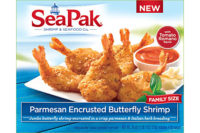Freeze quality is essential when manufacturing well over a million baked and prepared food items a day for shipment nationwide. Nation Pizza & Foods, LLC, Schaumburg, Ill., first started high-volume production of topped frozen pizza in 1987. In the late ’90s, it introduced a “crispy crust” technology that allowed breads to stay crisp in the microwave, which was later applied to microwaveable sandwiches.
Today, this innovator is one of the largest private label frozen food manufacturers in the United States, bringing an endless variety of products—high-end, high-quality pizzas, toasted subs, paninis, bruschetta, garlic toast and breakfast items— to market quickly.
Three Linde nitrogen spiral freezers apply a quality freeze on a range of high-volume products at Nation’s nearly 200,000-square-foot facility. To meet new demand for a premium national brand of frozen pizza, Vince Nasti, vice president of operations for Nation’s, turned to the food team at Linde LLC, Murray Hill, N.J. In turn, Linde performed annual audits on the compact cryogenic spiral freezers since first being installed more than 10 years ago, and upgraded new proprietary features as they became commercially available.
“A lot of what drives our enhancements is cost and efficiency. We’re always looking to increase our production rates and freeze at a lower cost per pound. With the support of Linde’s engineering team and industry expertise, we’ve been able to run these freezers not only more efficiently to get more throughput, but also at a lower cost per pound while maintaining quality,” says Nasti.
To address the needs of Nation’s for-higher-capacity within its existing facility, Linde focused on the line that primarily processes premium pizzas, ranging from 3- to 16-inch pies, from plain to multiple toppings. Frozen specialty crusts convey down the line and are topped with refrigerated ingredients before traveling into the cryogenic spiral freezer and out into packaging.
The Linde spiral freezer operates colder than -100°F. It uses a direct spray of cryogenic nitrogen to ensure toppings are firmly frozen to the pizza prior to final packaging. This is critical because in the hyper-competitive market for frozen pizza, appearance signals product quality and freshness. Excess sauce should not bleed through cheese, and other toppings such as sausage, peppers, pepperoni and onions must remain in place and frost-free.
After product exits the spiral freezer, Nation’s can either shrink wrap or send product for modified atmosphere packaging (MAP). When MAP is required (as with the premium pizza line), the oxygen is flushed from the bags with Linde carbon dioxide and/or nitrogen MAP gases.
“MAP extends shelf life and helps give a premium look for both pizzas and sandwiches,” says Nasti.
Linde’s spiral freezers are hygienically designed for high efficiency and operate with a proprietary exhaust system that automatically ramps up or down with production. As part of the annual audit process, Linde engineers ensure that the heat load of the food, cryogen use and the exhaust system are all operating in unison.
After Linde helped optimize the freezer with Nation’s, production on the premium line ramped up to achieve a substantial increase in volume in the same compact footprint. Further optimization of the exhaust system identified an opportunity to reduce operating costs an estimated $50,000 a year.
“Linde works with us,” Nasti says. “They take measurements. They examine the entire process with an understanding of what we’re looking for, and they come back with a solution.”



